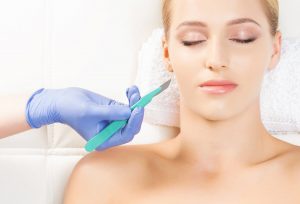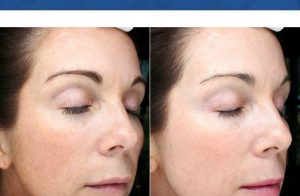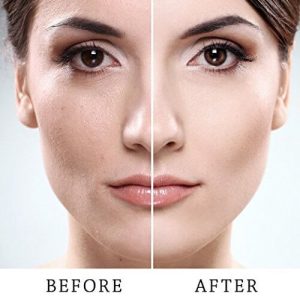Dermaplaning Chicago
Do you have peach fuzz, or those short, thin, barely visible hairs you got as a child? You might have it on your chin or your cheeks. Perhaps it always was a source of embarrassment for you. After all, you pluck your eyebrows and maintain a groomed facial appearance; why would you let peach fuzz slide? We have a procedure at SpaForever that can clean up your appearance, saving you the time and frustration of plucking each fine hair. It’s called dermaplaning Chicago. Read to learn more!
What is Vellus Hair?
Vellus hair or peach fuzz consists of the short, fuzzy-looking hairs that are thin and barely noticeable to the human eye. In contrast to terminal hair, vellus hair is much thinner, softer, shorter and lighter in color. Terminal hair is the hair we all know: thick, coarse, long and dark. If you’re already on top of managing your terminal hair (through laser hair removal), why not address vellus hair? With the proliferation of high-magnification mirrors and selfie culture, peach fuzz is becoming noticeable. If you’re looking for an effective solution, dermaplaning is the answer.
 What is Dermaplaning?
What is Dermaplaning?
It would be incomplete to call dermaplaning a hair removal method; in fact, it is an exfoliative procedure like microdermabrasion that scrapes top layer of skin to remove dead skin cells. The practitioner carefully applies a sterile scalpel blade to the face to scrape off the excess, dull skin and effectively remove vellus hair at the same time. It’s an effective method at controlling the facial presentation and safe, especially performed in our cosmetic office.
Does it Hurt?
If you’re curious what dermaplaning feels like, rest assured it’s fairly painless! Although a blade is used over the face to cut the dead skin and ‘baby hairs’ off, it’s not particularly abrasive or invasive. The blade carefully, systematically aids the removal of the top layer without causing damage or discomfort. Of course, you’ll feel pressure and perhaps wince at the blade’s proximity to your face. We can work with your comfort level, adjusting our application speed to your liking.
 What are Some Benefits?
What are Some Benefits?
Similar to microdermabrasion, dermaplaning can help skin better use topical skin care. The reason is simple; dead skin can form an occlusive layer on top and absorb any product you apply, while younger layers below struggle to incorporate the ingredients. Products can better penetrate skin following this procedure due to the exfoliative function of dermaplaning.
Not only will your skin more effectively use skin care; it simply will appear brighter and more radiant! Some people have attributed the following benefits to dermaplaning:*
- Fade fine lines
- Smooth acne scarring
- Improve skin texture and tone
- Temporarily remove/blunt vellus hair
- Trigger cellular turnover
- Enhance penetration of topical skin care
What are Other Methods for Vellus Hair Removal?
If you think more convenient vellus hair removal methods exist, you may be in for a surprise. First off, traditional hair removal methods work but are difficult to replicate on the vellus hairs. Take waxing. Not only can it strip the skin of its oils and imperfectly remove hairs, waxing can cause a host of hair-related problems such as ingrown hairs and micro-tears in skin. Another option, bleaching, may be ineffective at masking vellus hairs. Not to mention, many people have blonde or lightly-colored ones, rendering bleaching irrelevant. Lastly, shaving is hard to perform correctly. The risks for unintended nicks, rashes and infections rule out this more traditional method.
 Who Should Get Dermaplaning?
Who Should Get Dermaplaning?
Good news: If you’re pregnant, this is a low-risk procedure. Bad news: If you have a skin condition such as rosacea, eczema or cystic acne, dermaplaning may irritate your skin. However, we can assess your skin’s history and needs to make a judgmental call on whether you/your skin will tolerate dermaplaning Chicago. When you receive this procedure, your skin may love it or hate it, simply put. This goes with any cosmetic treatment we offer, so a consultation is required.
What are the Side Effects?
Immediately following the treatment, you may experience redness, dryness, irritation and other minor discomfort.* Your skin may feel more exposed and in fact will be more sensitive to the sun (requiring SPF). Don’t worry; dermaplaning triggers cellular regeneration, so younger skin cells will surface and provide the protective function skin normally does. This procedure requires no downtime, so you won’t have to stay inside all day to hide your face!
What is the Procedure Like?
The dermaplaning session will take approximately half an hour. You’ll come in and the practitioner will cleanse and dry your face. She will hold your skin tight and apply the scalpel blade at a 45-degree angle to make short, quick strokes.
 How Often Should I Receive This Treatment?
How Often Should I Receive This Treatment?
If you want to benefit regularly from dermaplaning, come in every 4 to 6 weeks! You want your skin to accumulate dead skin cells, which the procedure can help remove for a brighter complexion. There’s no need to go too frequently, as you need dermaplaning to perform the function it is intended.
How is Dermaplaning Distinct From Chemical Peels?
Like dermaplaning, chemical peels remove dead skin cells. The difference is the mechanism. Dermaplaning uses a mechanical tool, while chemical peels use chemical agents. Which treatment you prefer is up to you, although they can complement one another.
How is Dermaplaning Distinct from Microdermabrasion?
Dermaplaning is also strikingly similar to microdermabrasion, a procedure that uses a diamond tip and vacuum to lift and suck away dead skin cells. Both dermaplaning and microdermabrasion require a high level of technique based on the skills of the practitioner. However, dermaplaning doesn’t have a vacuum function and relies solely on the manual motion of the sharp edge to remove the top layer of skin. The diamond tip loosens the skin cells (without scratching) so that the vacuum can finish the job, while dermaplaning depends on dead skin falling off naturally.
Does Dermaplaning Help with Acne?
In short, no. Dermaplaning does not help with overproduction of the sebaceous glands. If you have acne, a treatment such as a chemical peel can help balance bacterial and oil-related activity inside the skin. We also offer both teenage and adult facials for acne-prone skin.
Are you Eager to Tone, Smooth and Clarify Your Complexion?*
Are you After More Glowing, Refreshed Skin?*
Do you Want a Treatment that Helps Other Treatments Work Better?*
Book a dermaplaning Chicago appointment at SpaForever today! We recommend a combination of Dermaplaning & Chemical Peel.
*Individual results will vary. We cannot guarantee results.
